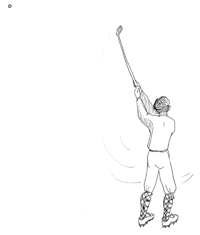STRANGEBUTTRUE- Dimpled balls: Why smoothies get left behind

DRAWING BY DEBORAH DERR McCLINTOCK
Q. In golf's early days, why did weekend duffers outdistance aristocratic swingers in drives off the tee? –S. Snead
A. Because the affluent used smooth balls and routinely discarded them after the first signs of wear, says John Eric Goff in Gold Medal Physics: The Science of Sports. Other golfers settled for the used balls and before long noted that the ones with nicks and cuts went farther. Today, based on myriad analyses by aerodynamic experts using wind tunnels, golf balls are made with dimples that simulate this roughened surface. Without them, the 300-yard-drives of pro golfers wouldn't make it half as far.
Though it might seem contradictory, balls with surface roughness experience less air drag than smooth ones, something not really understood until the turn of the twentieth century. Because of the greater surface friction on the spinning ball, a "boundary layer" of air forms that keeps incoming air from reaching the ball's surface. In fact, most sports balls have some type of surface imperfection, such as the prominent stitches on a baseball or football.
"It's doubtful that the first person to stitch up a baseball had fluid mechanics in mind. But were it not for those wonderful 108 double stitches on a baseball, home runs in today's parks would be almost non-existent," Goff writes.
Q. Even a dying person can talk, so it must take very little energy to utter those "famous last words." How little? –D. Mountjoy
A. Making the statement "Joe took Father's workbench out" in normal voice requires about 2 seconds and generates power of barely 15-20 microwatts, says John R. Cameron in Physics of the Body. "A person could talk continuously for 100 years and still not produce the sound energy equivalent to the heat energy needed to bring a cup of water to the boil," he adds.
Of the power generated, most goes into vowels, rendering them easier to hear and understand, such as the sound intensity in "awl" compared to the consonant "th" in "thin" testing at 680:1 difference. But for patients with voicebox removed, says Cameron, even this small talk energy can't be mustered. So they're taught to swallow air and belch it back in controlled fashion to act as an artificial larynx to produce communicative sound.
Q. Maybe you're not a millionaire, but if you were one, flush with single dollar bills, could you count them all? –H. Minor
A. Do you have some time on your hands? On average, it takes about one second to speak out a two-digit number and about five seconds to say a six-digit number, say Alfred Posamentier and Ingmar Lehmann in Mathematical Amazements
and Surprises.
So let's use an average of four seconds per count. Supposing you begin your dollar-counting exercise right now, 24 hours per day, 60 minutes per hour, 60 seconds per minute, you would reach 1,000,000 in about 46 days. But that's without any breaks. Are you hungry yet?
At least for this exercise, let's just hope you haven't gotten into business and become a billionaire, because now you'd have to count 1,000 times as long. By this measure, only you "super-centenarians" could ever hope to complete the 130-year task!
~
Send Strange questions to brothers Bill and Rich at [email protected]
#